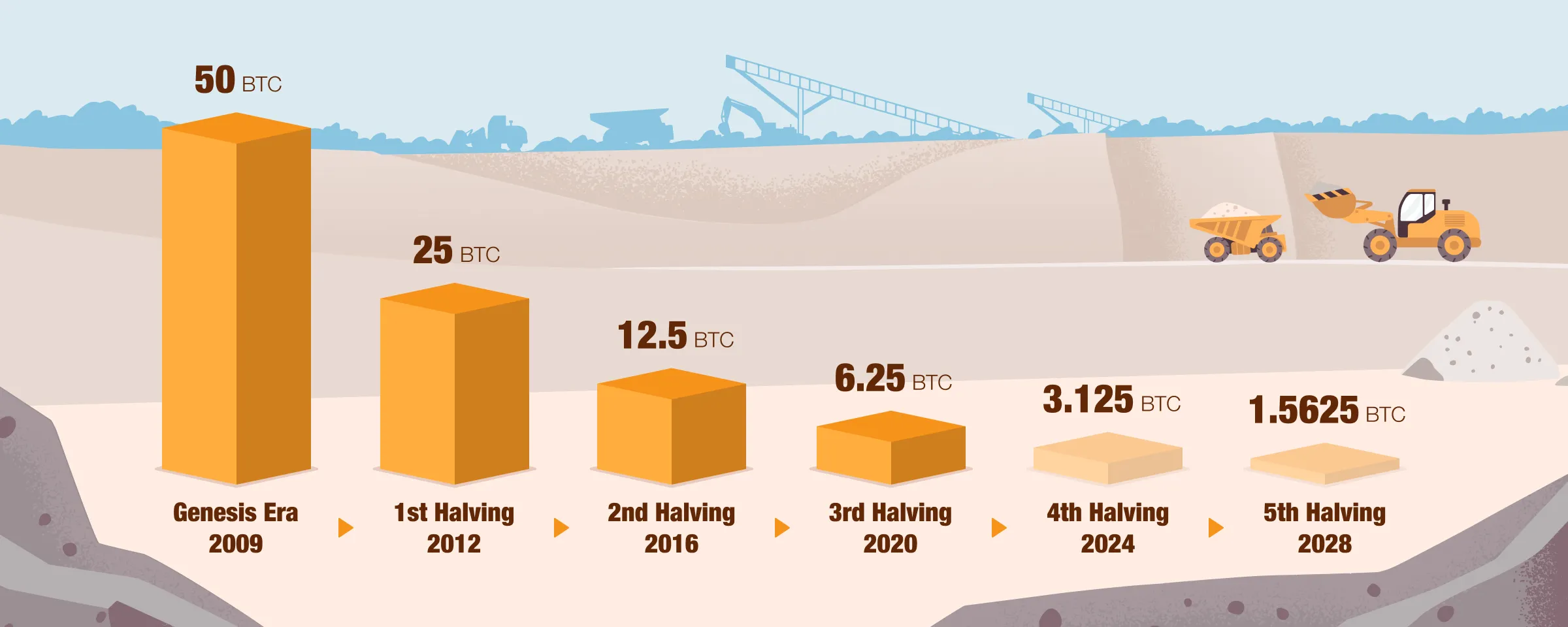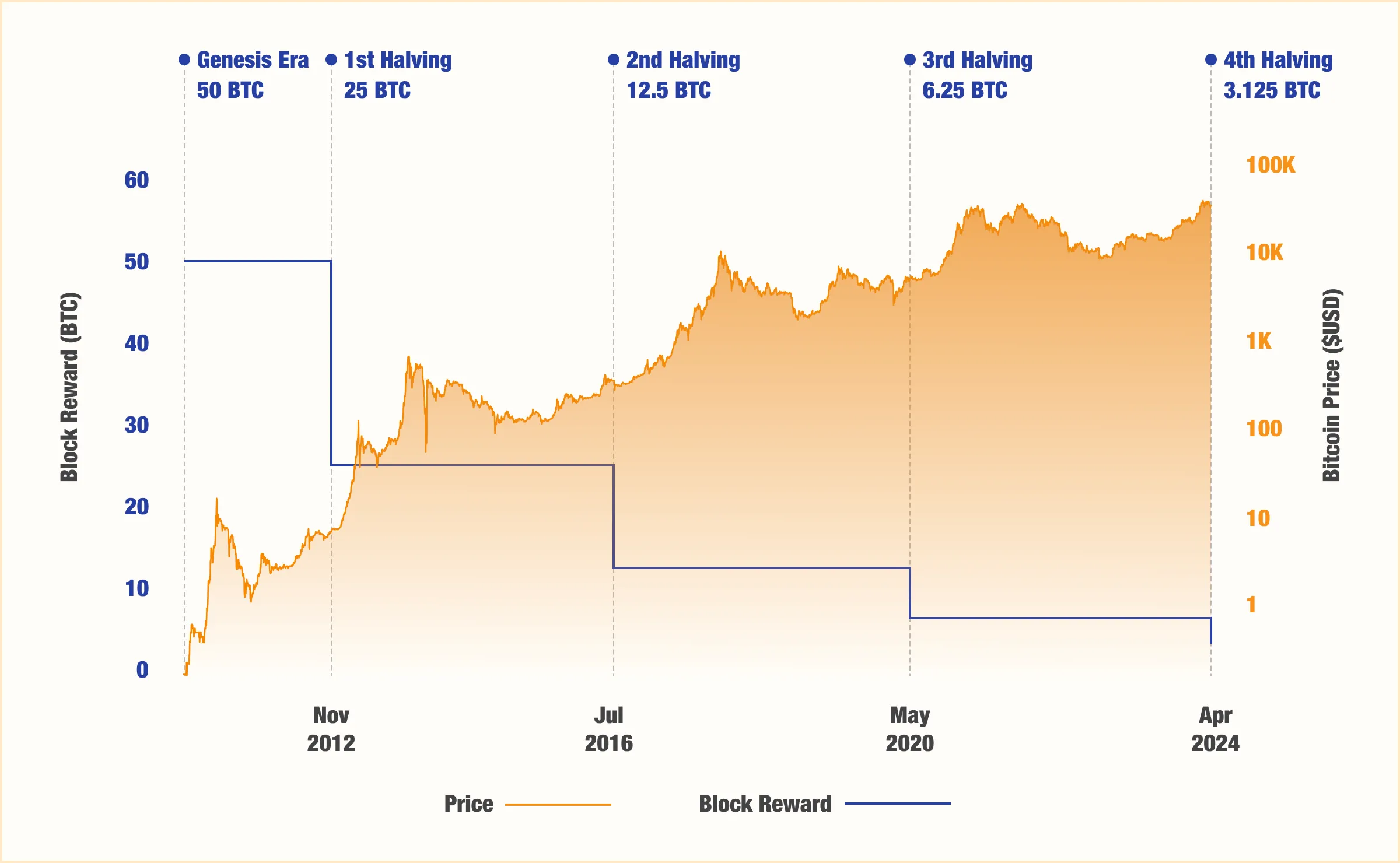Crypto 101: Bitcoin Halving History and Impact

What is the Bitcoin Halving?
The Bitcoin Halving is one of the most important features of the Bitcoin protocol. Approximately every four years (210,000 blocks), the amount of BTC that is rewarded for successfully mining a block is cut in half (not including transaction fees). The Bitcoin Halving cycle is a predictable, immutable method of fairly distributing new coins through a proof-of-work process.

The Impact of the Bitcoin Halving on Price
Each Bitcoin Halving reduces by 50% the supply of new BTC coming into circulation. This supply-control mechanism, modeled in part on precious metals mining, makes Bitcoin increasingly scarce over time. Bitcoin’s rate of inflation will continue to decrease until it is 0% when all 21,000,000 BTC have been mined, which is projected to occur in the year 2140.
As a result of the basic principles of supply and demand, Bitcoin has historically experienced dramatic price volatility leading up to and following each previous Halving. The Halving is widely considered to be one of the most important factors affecting the price of Bitcoin, as illustrated by the chart below, and few believe that the 2024 Halving will be different.

With the 2024 Bitcoin Halving rapidly approaching, a retrospective look at the 2020 Halving may offer valuable lessons for navigating profitably through the upcoming event. Bitcoin continues to generate immense attention with its quadrennial Halvings, which reduce its currency issuance rate and significantly impact the market every four years.
The 2020 Halving left a lasting imprint on the ecosystem, affecting everything from market volatility and mining operations to transaction fee dynamics, institutional investment, and public engagement.
This article examines the outcomes and strategic shifts triggered by the last Halving and considers the broader implications of such pivotal moments in digital finance. Our exploration seeks to equip investors, miners, and entrepreneurs with the foresight needed to navigate the 2024 Halving, leveraging the past to prepare for the future.
1. Market Volatility
The 2020 Bitcoin Halving demonstrated its potential for extreme price volatility. This volatility wasn’t merely a function of the Halving itself but was compounded by external variables. Notably, the collapse of prominent cryptocurrency exchanges like FTX introduced sharp negative price corrections, while sovereign adoption narratives, exemplified by El Salvador’s integration of Bitcoin, provided a foundational demand that could underpin long-term valuation support. The Salvadoran precedent hints at the potential market recalibration should larger economies emulate this adoption strategy.
Pre-Halving Bitcoin hovered around $8,800 in May 2020, with subsequent price action reflecting both micro and macroeconomic influences. With the 2024 Halving on the horizon, the lesson for investors is to brace for unpredictability, eschewing short-term speculation in favor of a strategic, long-term approach.
Market complexity mandates a disciplined investment philosophy, one that eschews emotional responses to market movements in favor of patient, informed decision-making.
2. Miner Consolidation and Efficiency
The 2020 Halving put pressure on miners, especially those with higher operational costs, leading to a consolidation in the mining industry. This transformation was not merely about profitability but also hinted at an unintended drift towards centralization, as miners with access to cheap electricity and advanced mining hardware fared better, while the block reward halved from 12.5 to 6.25 BTC. This trend is likely to intensify by the 2024 Halving, with further reductions in block rewards necessitating even greater efficiency and potentially leading to more significant consolidation and centralization. Such centralization poses questions about the security of the network, as the distribution of mining power becomes less widespread.
Miners should continue to invest in energy efficiency and explore sustainable practices to remain competitive, ensuring that the transformative path towards efficiency does not compromise the decentralized and secure nature that is foundational to Bitcoin. This underscores the importance of understanding the network’s fundamentals, including how miners play a critical role in its security and functionality.
3. Transaction Fees Increase
As block rewards halved in 2020, transaction fees became a more substantial part of miners’ revenue, marking a significant shift in the Bitcoin ecosystem’s economics. This evolution underscores the growing importance of transaction fees for the sustainability of mining operations and the overall security of the network.
The first Halving in 2012 and subsequent ones have led to increased discussion around the scalability and cost-effectiveness of Bitcoin transactions. With the upcoming 2024 Halving reducing block rewards further to 3.125 BTC, there’s an anticipated increase in reliance on transaction fees. This shift could influence Bitcoin’s mainstream adoption, as higher transaction costs may deter casual users and small transactions.
However, the development and implementation of scaling solutions, particularly the Lightning Network, aim to address these challenges by enabling faster and cheaper transactions off the main blockchain.
For beginners interested in navigating this evolving landscape, a basic piece of advice is to stay informed about the latest developments in Bitcoin’s scaling solutions and consider using wallets and services that support the Lightning Network for smaller, everyday transactions.
This approach will help ensure that your experience with Bitcoin remains efficient and cost-effective, even as the network continues to adapt and grow. And in the near future, traditional banks and payment service providers will add significant transaction capacity to the network by allowing customers to conduct custodial off-chain transactions with BTC-denominated accounts.
4. Increased Institutional Interest
The period surrounding the 2020 Bitcoin Halving was marked by a dramatic swell in institutional engagement, underscoring Bitcoin’s escalating appeal as a solid investment and a reputable member of the digital asset class. Significant moves by leading financial powerhouses and publicly traded entities to incorporate Bitcoin into their treasury strategies illustrated a burgeoning trust in its long-term value.
Michael Saylor’s MicroStrategy made a bold foray into Bitcoin investment, pouring hundreds of millions into the digital currency. Similarly, Jack Dorsey’s Square signaled a watershed moment for institutional backing with its substantial Bitcoin purchase. Additionally, PayPal announced in late 2020 that it would allow its users to buy, hold, and sell cryptocurrencies, including Bitcoin, directly from their PayPal accounts, marking a significant step towards mainstream adoption.
These moves not only legitimized Bitcoin investment for a broad audience but also underscored the trend towards wider acceptance. These actions by leading firms fortified Bitcoin’s base, heralding a new level of stability and growth potential. The enthusiastic embrace of Bitcoin by these corporations signals a shift towards broader acceptance and reliance on digital currencies in traditional financial circles, potentially inspiring a wave of similar investments across the sector.
Looking forward to the 2024 Halving, the momentum is expected to pick up pace, with the advent of new financial instruments like Bitcoin ETFs likely to catalyze further recognition and adoption of cryptocurrencies. These several new Bitcoin ETFs, introduced by titans such as BlackRock and Fidelity, have already had tremendous influence, bringing Bitcoin firmly into the financial mainstream.
As this trend of increased acceptance and legitimization continues, it is inevitably attracting significant attention from the public and the media.
5. Public and Media Attention
As Bitcoin approached its 2020 Halving, the event became a focal point for increased media coverage and public interest, with frequent coverage on mainstream business media channels such as CNBC and Bloomberg. This heightened awareness, sometimes marred by smear campaigns or disinformation, has not only attracted a wave of new enthusiasts and investors but also initiated important conversations about the future of money, investment, and the decentralization of financial systems.
Looking ahead to the 2024 Halving, the anticipation builds, promising to amplify Bitcoin’s presence further as a significant digital asset within the mainstream sector. Such momentum underscores the importance of prioritizing transparency and informed discourse to counter disinformation and foster a well-educated Bitcoin community.
6. How Investors Should Prepare
Investors who had prepared for the 2020 Halving with a clear strategy, grounded in the fundamentals of Bitcoin’s economy and security features, found themselves in an advantageous position to navigate its outcomes. This preparation, emphasizing a deep understanding of Bitcoin’s technical and market dynamics, allowed them to make informed decisions, avoiding the pitfalls of emotional investing, and capitalize on the event’s impact.
The Halving, a crucial part of Bitcoin’s four-year cycle, significantly influences the network by reducing miner rewards, thereby affecting supply and potentially increasing Bitcoin’s value. Investors who recognized these patterns and the role of miners in maintaining network security were better positioned to adjust their portfolios in anticipation of the market’s reaction.
For those looking towards the 2024 Halving, it’s essential to monitor these cyclical changes, understand the balance between supply and demand, and consider the broader economic landscape that could affect Bitcoin’s price. Engaging with these insights can provide a more strategic approach to Bitcoin investment, enhancing the potential for positive returns.
The impact from the 2020 Bitcoin Halving extend far beyond simple market predictions, offering a roadmap for strategic, forward-thinking investment. The nuanced understanding of factors such as market volatility, miner consolidation, the increasing importance of transaction fees, burgeoning institutional interest, and the pivotal role of public and media attention underscores the multifaceted impact of the Halving events.
For investors, miners, and cryptocurrency enthusiasts, adopting a disciplined, informed approach — rooted in the broader implications of these pivotal developments — will be key to navigating the future landscape of digital finance. This essay aims not just to reflect on past events but to inspire a proactive, strategic stance as we move into the next chapter of Bitcoin’s evolution.
Ballet Bitcoin Halving Limited Edition
Commemorate the 2024 Bitcoin Halving with a limited edition Ballet Cold Storage Card. This exclusive release features a unique design to mark the start of a new era in Bitcoin history.

Get Started with Ballet Cold Wallets Today
With Ballet Cold Wallets, you can rest assured that your cryptocurrencies are stored safely offline, protected from hackers and online threats. Don’t wait until it’s too late—take the first step in securing your digital assets today. Invest in the security of your Bitcoin with a Ballet Cold Wallet and protect your investments for the future.
Useful Links:
Ballet Official Online Store
Anti-Counterfeiting Guide
Download Ballet Crypto App
Ballet YouTube Channel
